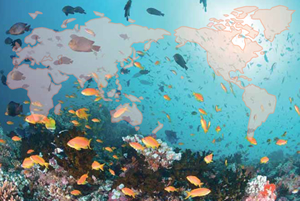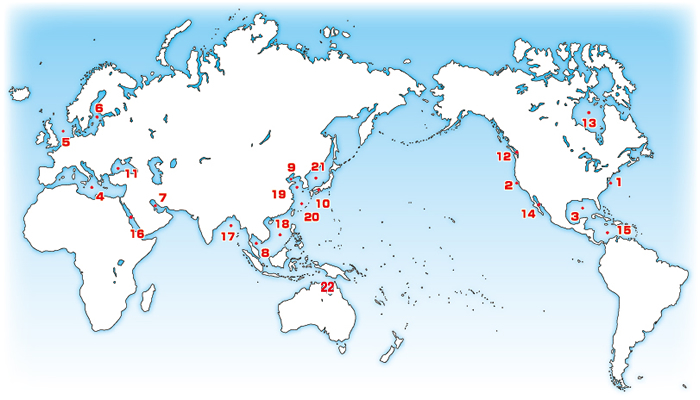The World's Enclosed Coastal Seas
The Environmental Management of Enclosed Coastal Seas Protecting Our Coastal Seas for Future Generations

In many parts of the world there are bodies of sea water that are almost entirely enclosed by land. These bodies of water are called enclosed coastal seas. Examples include the Mediterranean Sea, the Baltic Sea, Chesapeake Bay, the Gulf of Thailand, the Bo Hai in northern China and, in Japan, the Seto Inland Sea, Tokyo Bay and Ise Bay. Since ancient times, enclosed coastal seas have been known for their great scenic beauty. Their outstanding natural attributes have spurred the development of transportation networks and many types of industry in the ocean and coastal regions, and they have been the setting for cultural and recreational activities throughout the ages. But man’s activities have exceeded the natural ability of the seas to cleanse themselves, giving rise to problems of pollution in the world’s enclosed coastal seas such as eutrophication, “red tides” and “blue tides”. We must work to preserve these priceless natural treasures if we are to pass them onto future generations.
Major Enclosed Coastal Seas of the World

- Chesapeake Bay(11,603km2,6.4m)
- San Francisco Bay(1,040km2,6m)
- Gulf of Mexico(1,592,800km2,1,486m)
- Mediterranean Sea(2,536,000km2,>5,150m)
- North Sea(575,200km2,94m)
- Baltic Sea(422,200km2,55m)
- Persian Sea(233,000km2,35m)
- Gulf of Thailand(320,000km2,45m)
- Bohai Sea(77,284km2,26m)
- Seto Inland Sea(23,203km2,38m)
- Black Sea(508,000km2,1,240m)
- Puget Sound(2,600km2,>300m)
- Hudson Bay(1,232,300km2,128m)
- Gulf of California(153,000km2,1,200m)
- Caribbean Sea(2,718,200km2,2,647m)
- Red Sea(438,000km2,491m)
- Bay of Bengal(2,173,000km2,2,600m)
- South China Sea(2,319,000km2,1,652m)
- Yellow Sea(466,200km2,40m)
- East China Sea(735,800km2,175m)
- Sea of Japan(978,000km2,1,752m)
- Gulf of Carpentaria(370,000km2,60m)
※area, average depth, > maximum depth
Environmental Guidebook on the Enclosed Coastal Seas of the World(9MB/PDF)
Enclosed Coastal Seas in the World.pdf
| No | Sea area | Dimensions | Main Environmental Problems |
Environmental Protection Measures |
Related Organizations and NGOs | 1.Area Guide 2.Current Status and New Directions |
|---|---|---|---|---|---|---|
| 1 | Chesapeake Bay | Surface Area 11,603km2 Volume 68.1km3 Average Depth 6.4m |
|
1.Area Guide 2. Robert M. Summers, 2018. |
||
| 2 | San Francisco Bay | Surface Area 1,040km2 Volume 7km3 Average Depth 6m |
|
1.Area Guide |
||
| 3 | Gulf of Mexico | Surface Area 1,592,800km2 Volume 2,366,901km3 Average Depth 1,486m |
|
1.Area Guide |
||
| 4 | Mediterranean Sea | Surface Area 2,536,000km2 Volume 3,750,000km3 Average Depth - |
|
1.Area Guide |
||
| 5 | North Sea | Surface Area 575,200km2 Volume 54,069km3 Average Depth 94m |
|
|
1.Area Guide 2. Jean-Paul Ductoroy, 2018. |
|
| 6 | Baltic Sea | Surface Area 422,200km2 Volume 23,221km3 Average Depth 55m |
|
1.Area Guide |
||
| 7 | Persian Gulf | Surface Area 233,000km2 Volume 8,155km3 Average Depth 35m |
|
|
|
1.Area Guide |
| 8 | Gulf of Thailand | Surface Area 320,000km2 Volume 14,400km3 Average Depth 45m |
|
1.Area Guide 2. Menasveta, P.,Chavanich, S., Jarupongskul, T., 2019. |
||
| 9 | Bohai Sea | Surface Area 77,284km2 Volume 2,009km3 Average Depth 26m |
|
|
1.Area Guide 2. Yanfang Li, 2019. |
|
| 10 | Seto Inland Sea | Surface Area 23,203km2 Volume 881.5km3 Average Depth 38m |
|
|
1.Area Guide 2.Osamu Matuda, 2017. |
|
| 11 | Black Sea | Surface Area 508,000km2 Volume 629,920km3 Average Depth 1,240m |
|
1.Area Guide 2.Ruben Kosyan, 2019. |
||
| 12 | Puget Sound | Surface Area 2,600km2 Volume 169km3 Average Depth - |
|
1.Area Guide |
||
| 13 | Hudson Bay | Surface Area 1,232,300km2 Volume 157,734km3 Average Depth 128m |
|
1.Area Guide |
||
| 14 | Gulf of California | Surface Area 153,000km2 Volume 183,600km3 Average Depth 1,200m |
|
|
|
1.Area Guide |
| 15 | Caribbean Sea | Surface Area 2,718,200km2 Volume 7,195,075km3 Average Depth 2,647m |
|
|
1.Area Guide |
|
| 16 | Red Sea | Surface Area 438,000km2 Volume 215,058km3 Average Depth 491m |
|
1.Area Guide |
||
| 17 | Bay of Bengal | Surface Area 2,173,000km2 Volume 5,649,800km3 Average Depth 2,600m |
|
1.Area Guide |
| |
| 18 | South China Sea | Surface Area 2,319,000km2 Volume 3,830,988km3 Average Depth 1,652m |
|
1.Area Guide |
||
| 19 | Yellow Sea | Surface Area 466,200km2 Volume 18,648km3 Average Depth 40m |
|
|
1.Area Guide |
|
| 20 | East China Sea | Surface Area 735,800km2 Volume 128,765km3 Average Depth 175m |
|
1.Area Guide 2.Zhongyuan Chen, 2019. |
||
| 21 | Sea of Japan | Surface Area 978,000km2 Volume 1,713,456km3 Average Depth 1,752m |
|
|
|
1.Area Guide |
| 22 | Gulf of Carpentaria | Surface Area 370,000km2 Volume 22,200km3 Average Depth 60m |
|
1. Ruth Patterson, 2019. New! 2. Improving certainty in marine ecosystems: A biophysical modelling approach in the remote, data-limited Gulf of Carpentaria |


